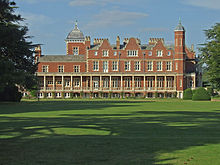Babraham
| Babraham | |
|---|---|
 The George Inn, Babraham | |
Location withinCambridgeshire | |
| Population | 276 (2011 Census)[1] |
| OS grid reference | TL5150 |
| Civil parish |
|
| District | |
| Shire county | |
| Region | |
| Country | England |
| Sovereign state | United Kingdom |
| Post town | CAMBRIDGE |
| Postcode district | CB22 |
| Dialling code | 01223 |
| Police | Cambridgeshire |
| Fire | Cambridgeshire |
| Ambulance | East of England |
Babrahamis a village andcivil parishin theSouth Cambridgeshiredistrict ofCambridgeshire,England, about 6 miles (9.7 km) south-east ofCambridgeon theA1307 road.

Babraham is home to theBabraham Institutewhich undertakes research intocellandmolecular biology.
History
[edit]The parish of Babraham covers an area of 2,387 acres (966 ha) and is roughly rectangular in shape. Its straight northern boundary is formed by the ancientWool Street,separating it fromFulbourn,and its eastern border follows theIcknield Way(now theA11), separating it fromLittle Abington.The remaining boundaries withStapleford,SawstonandPampisfordare formed by field boundaries and a small section of theRiver Granta,on which the village lies.[2]
The course of the River Granta through the parish has been changed on numerous occasions; a watermill was listed as valueless in the 14th century when the river had changed course, and additional water channels have been dug for irrigation as well as to form an ornamental canal alongside Babraham Hall. Severe floods hit Babraham in both 1655 and 1749.[2]
Traces of a Roman villa have been found on its parish boundary with Stapleford. It has also been suggested that the village has moved site, the principal evidence being that the church is 400 metres (440 yd) from the present village. Babraham was comparatively wealthy during medieval times due to its wool trade, with the highest tax returns in itshundred.In the late 16th century the manor was the principal seat of the great Elizabethan merchant and financier SirHoratio Palavicino.[3]Between 1632 and the 19th century, the manor was owned by the Bennet, and later the Adeane, families, who lived in Babraham Hall.[2]The Hall was built in 1833 by Henry John Adeane.[4]
Listed asBadburghamin theDomesday Bookof 1086, the village's name means "homestead or village of a woman called Beaduburh".[5]This version of the name was also used in the 15th century, as the home village of an ostler called Roger Baldok, in a Plea Roll of theCourt of Common Pleas.[6]
John Hullierwas vicar of the parish of Babraham from 1549 until he was deprived in February 1556.[7]On 16 April 1556 he was burned at the stake onJesus Green,Cambridge for refusing to renounce the Protestant faith.[4]The antiquaryWilliam Colelived in Babraham as a child when his father was the steward of the owners of Babraham Hall.[2]In the 19th century Babraham was home toJonas Webb,a noted stock breeder who played a pivotal role in developing theSouthdownbreed of sheep.[4]
Church
[edit]

There was probably a church in the village at the time of theNorman Conquest,though the first official record was in the late 12th century. The present parish church, dedicated toSt Petersince the 12th century, consists of a chancel, an aisled andclerestoriednave with north and south porches, and a west tower. There are two bells in the tower, both from 1614. The smaller weighs 11cwtand is cracked; the larger 13cwt.
The chancel and lower part of the tower date from the 13th century though there is evidence of an earlier building. The nave was completely rebuilt in the 15th century.[2]
Village life
[edit]The village contains a primary school called Babraham Primary School, which opened in 1959. It also retains one public house, The George, which was already open as an inn in 1488 but rebuilt in around 1600. There have been inns listed in the village from the 13th century, presumably on the Icknield Way at Bourn Bridge. Other former inns include The Angel, listed in 1490, The Swan, open in the 16th century, and The Chequer and The Griffin, all four of which were still open in 1600. Three ale-house licences were awarded to the village in 1682.[2]
Babraham villagecricketteam won the Cambridgeshire Cricket Association Senior League in 2008.
Babraham in literature
[edit]F. L. Lucas's novelDoctor Dido(Cassell, London, 1938) is set in Babraham and its environs in the period 1792–1812. With much local and antiquarian detail, it tells the story of Samuel Plampin, Doctor of Divinity at Cambridge and vicar of St Peter's Babraham, who brings to the vicarage as his housekeeper a young Frenchwoman he finds in Cambridge, a destitute refugee fromthe Terror.
Rupert Brooke's poemThe Old Vicarage, Grantchester,include the line "Strong men have cried like babes, bydam, To hear what happened at Babraham."
Evelyn Barnard's children's bookThe Brothers Are Walkingis set in Babraham.[4]
References
[edit]- ^"Census Maps".Archived fromthe originalon 28 July 2014.Retrieved25 July2014.
- ^abcdefA History of the County of Cambridge and the Isle of Ely.Vol. 6. 1978. pp. 19–30.
- ^Ian W. Archer, ‘Palavicino, Sir Horatio (c.1540–1600)’, Oxford Dictionary of National Biography, Oxford University Press, 2004; online edn, Jan 2008accessed 26 Dec 2013
- ^abcd"Babraham village - history".Archived fromthe originalon 4 June 2011.
- ^A. D. Mills (2003)."A Dictionary of British Place-Names".Encyclopedia.com.
- ^"AALT Page".Aalt.law.uh.edu.Retrieved4 March2019.
- ^"Parish (Church): Babraham (CCEd Location ID 853)".The Clergy of the Church of England Database 1540–1835.Retrieved5 February2014.

